The best mop will be something that wipes away spills, removes dirt, and doesn’t pass germs around from surface to surface. It’s lightweight, easy to maneuver, and, hopefully, affordable. Or, at least worth the investment.
To help you shop for the best one for (1) your space and (2) your cleaning needs, Post Wanted tested 7 mops from top brands like Bissell and Swiffer to put well-reviewed models head-to-head (or, rather, solution-to-floor).
- Best Mop Overall:
- Best Wet Mop:
- Best Mop for Tile Floors:
- Best Mop for Laminate Floors:
- Best Mop for Hardwood Floors:
- Best Spin Mop:
We’ve been using some models for upwards of four years, while others were recently paraded around our hard floors. Nevertheless, each mop has been tested for at least two weeks.
“You’ll want a mop that is high quality and versatile, as I always say, you get what you pay for,” , founder of Toronto-based cleaning service, Clean My Space (and author of her brand’s accompanying cleaning book), told the New York Post. “A cheaper, flimsy mop can’t tackle ground in dirt and it’s not going to last you a long time. You also want a mop that suits your lifestyle and the kind of flooring you have; a pet parent with laminate will need a different mop than someone who has no pet and all tile.”
Additionally, Maker highlights the 411 on mops — including what to look for and how to best use them — in our in-depth FAQ section.
Best Mop Overall:
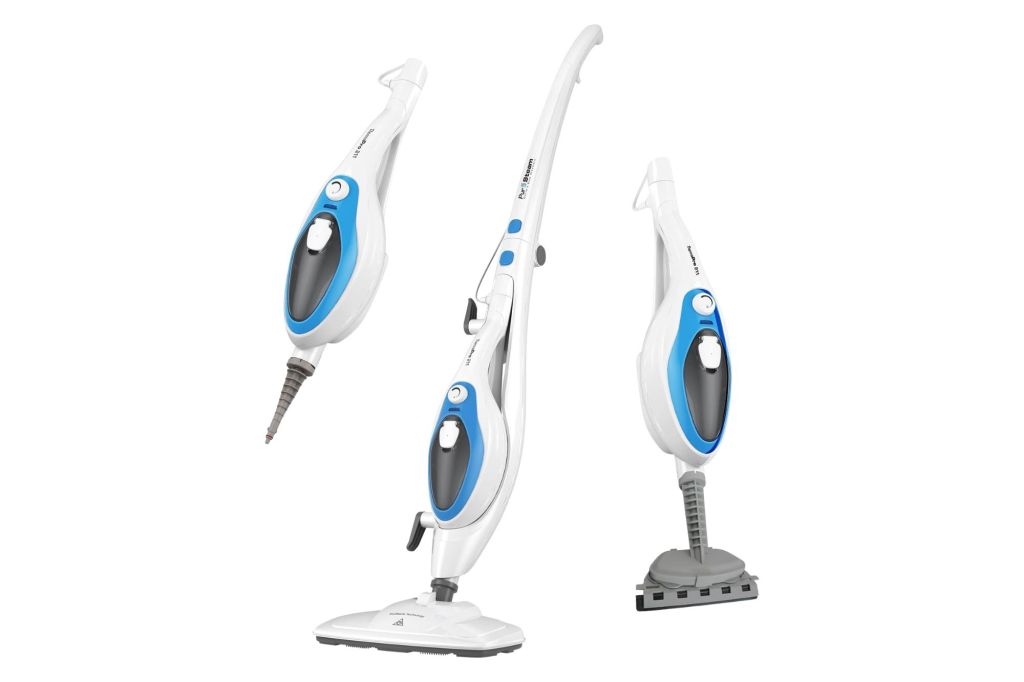
Pros:
- Detaches into a handheld cleaner
- Pivoting head to clean hard to reach places
- Can also be used on drapes and upholstery
- Includes multiple cleaning accessories
- Small footprint
- More than 53,000 ratings on Amazon
Cons:
- Replacement pads are on the thin side
Perhaps you were expecting a BISSELL, Swifer or another big name brand in our top spot, but the PurSteam 10-in-1 Steam Mop has sold more than 8,000 times this month for a reason. The steam mop is exceptional at removing dirt from hard surfaces, including hardwood floors. It has a swivel head that’s excellent at pivoting around chair legs and other pieces of furniture. We also like that it’s low enough to reach underneath sofas. The head can be removed and placed with different tools for other types of cleaning, including upholstered furniture, windows, and even carpet because of its use of steam. There are two other versions of the steam mop, but this is our favorite (and the lowest in price).
What customers are saying: “This thing is amazing! You can literally see dirt disappearing when you use it. Going from the mop to the handheld function is super simple and easy, and all the various interchangeable tools work really well. It maneuvers in small spaces and corners to get every part clean, and the steam is strong and powerful. You can deep clean floors, baseboards, toilets, countertops, bathrooms, kitchens, and any other surface on a single fill of the water tank. Amazing for the money!”
Style: Steam mop | Surfaces: Tile, Sealed Wood, Laminate, Upholstery, Glass | Weight: 2.2 pounds | Includes: Therma Pro 211 Steam Mop, 2 Steam Mop Cleaning Pads, 3 Nylon Brush Attachment,Built-In Handheld Steamer, Nozzle AttachmentsTherma Pro 211 Steam Mop, 2 Steam Mop Cleaning Pads, 3 Nylon Brush Attachment,Built-In Handheld Steamer, Nozzle Attachments | Cord: n/a
Best Wet Mop:

Pros:
- Easy to attach mop head that rotates 360 degrees
- Built-in wringer
- Doubles as a duster
- Can be used on untreated wood floors
Cons:
- Handle could be stronger
Ask anyone what the best wet mop is, and they’ll say the O-Cedar EasyWring Microfiber Spin Mop. It looks like a traditional mop and bucket, but it’s so much more than that. The bucket has a built-in pedal that wrings the mop as much or as little as you need, eliminating the need to get your hands dirty. The bucket also has a splash guard to protect you (and your floors) as you move from one area to another.
Unsurprisingly, this is also one of the best mops (perhaps the best) for untreated wood. Simply pick your solution of choice (we find a mild soap mixed with water to be the best cleaning products for such a task)
The patented triange head rotates to clean corners and hard to reach places, like the crevice beneath the fridge and floor. The microfiber head is easy on more delicate surfaces, even when you’re exerting a lot of force. It’s also washable, making this a more eco-conscious mop option for those who dislike using disposable cleaning pads.
What customers are saying: “The swivel head at the top is very good at draining the mop head. I love the two compartments. Very easy to handle and pick up to dump water in and out of. The mop has cleaned the floors very well.”
Style: Wet mop | Surfaces: Finished hardwood, Laminate, Tile, Vinyl, Wood| Weight: 5.3 pounds | Includes: Mop, Bucket, 2 microfiber head refills
Best Mop for Tile Floors:
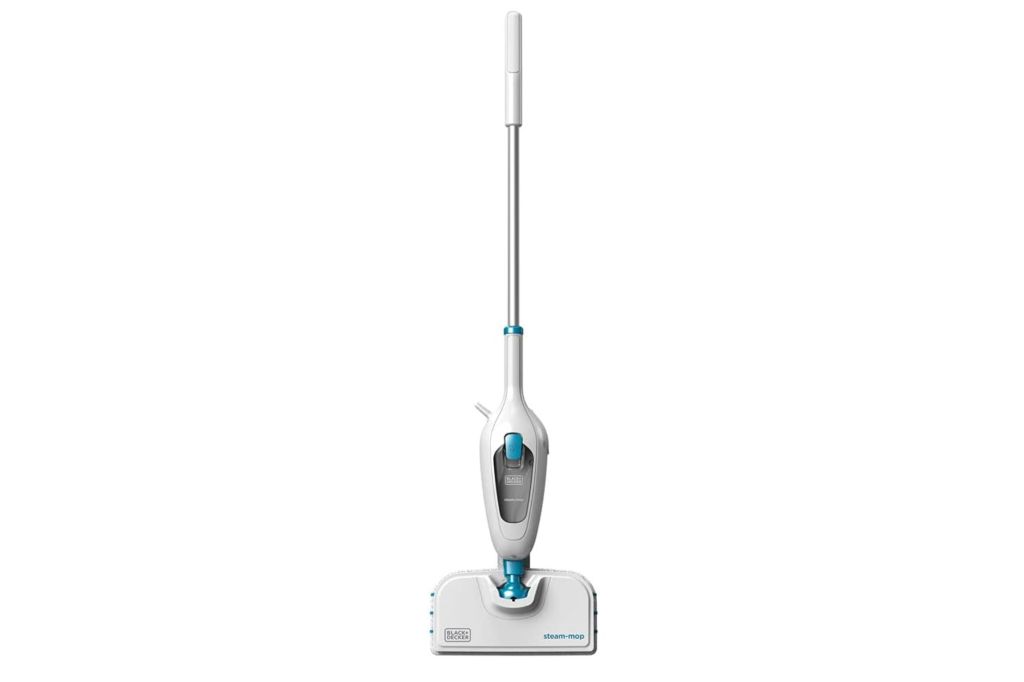
Pros:
- Water heats up in less than a minute
- No need for cleaning solution (or its replacement)
- Pivoting head to clean around and beneath furniture
Cons:
- Cord is on the shorter side
If you want something that will pick up the top layer of dirt and keep tile looking presentable, something like the will do. If you want your tiles to look pristine, however, go for the BLACK + DECKER Steam Mop. Its steam function dissolves grout so quickly that we practically cried when we thought of the bathroom floors we tried to scour without it.
The electric mop heats up in 30 seconds to kill germs and features a pivoting head to get around tight spots like between the sink and tub, around the toilets, and beneath radiators. It can be used on stone and granite, as well, and it’s fairly lightweight.
What customers are saying: “This steam mop is a game-changer! I’ve been using it daily for weeks, and it’s incredibly easy to use. It heats up fast, cleans effectively, and sanitizes without harsh chemicals. My floors have never looked better!”
Style: Steam mop | Surfaces: Laminate, Tile, Sealed Wood, Granite, Stone | Weight: 4.9 pounds | Includes: Classic Steam-Mop, 1 Microfiber pad, 1 jack plug | Cord: 12 feet
Best Mop for Laminate Floors:
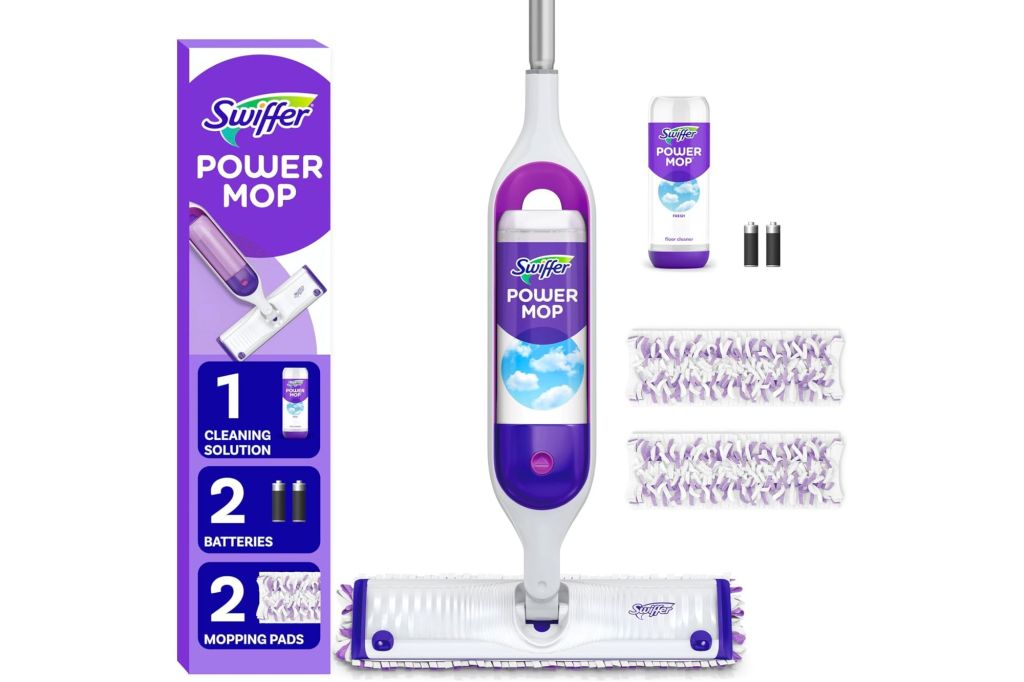
Pros:
- Best-seller on Amazon
- Quicker to use than a bucket and mop
- Includes cleaning solution
- Good for most surfaces
- Budget-friendly
Cons:
- Requires more effort to remove heavier stains
We found that the Swiffer PowderMop was the best when it came to cleaning laminate floors. Its pad has hundreds of absorbent cleaning strips that, when mixed with the included cleaning solution, effectively remove dried juice spills, dirt and mild stains. It’s not electric-powered, so it does require some elbow grease, but laminate, as a general rule, is typically easier to clean than delicate wood or tile, which often has muck within its grout line. Its spray jets cover a fair amount of surface as you move along, which should keep you from having to restock too soon. Also, it’s under $25, and the removable cleaning pads are more hygienic than a traditional cotton strip mop.
What customers are saying: “This is the best mop I’ve ever used. No more water buckets, no more water spilling. It’s very easy to assemble and it’s light weight I don’t even need to use both of my hands.”
Style: Spray mop | Surfaces: Laminate, Tile, Sealed Wood | Weight: 4.6 pounds | Includes: spray mop, 2 Swiffer Power Mop refills, 1 floor cleaner, and 2 batteries
Best Mop for Hardwood Floors:
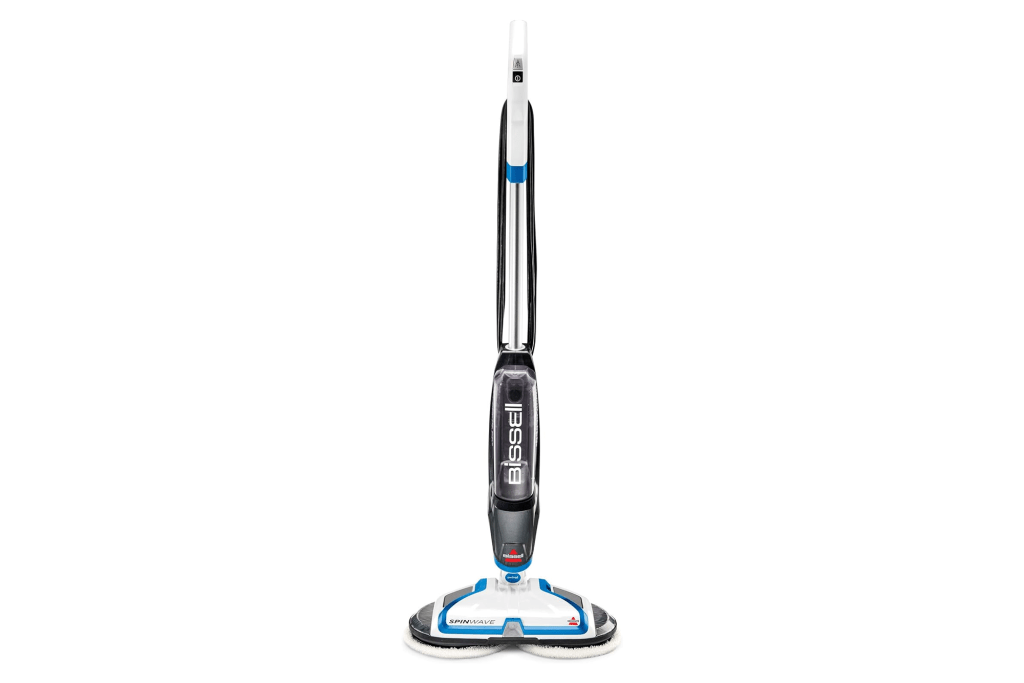
Pros:
- A unique spinning system ensures all debris and dirt are picked up
- Includes two reusable microfiber mop pads
- Has an on-demand spray function
Cons:
- Doesn’t have an adjustable handle, so it may be heavier for some users, especially those with upper-extremity disabilities
- The charging cord length could be longer
When I first used the Bissell SpinWave Hard Floor Spin Mop, I was instantly amazed by its unique spinning technology. It’s the perfect size, too; not too flimsy, not too bulky, and exceptional on hardwood floors.
Its spinning pads work like a high-powered buff job, making dull floors sparkle. They’re strong enough to dislodge bits of debris and gunk between floor boards while still being gentle enough not to scratch or mess with the sealant.
Although it may look complicated, it’s one of the simplest mops to use: start by inserting the corresponding solution into its slot and start mopping away. While there aren’t a litany of speed settings, there isn’t a need for them; the rotating spinning heads effectively remove debris. Plus, they’re washer-dryer safe when you need to give them a clean.
Two microfiber pads and detergent are included. When you need a restock, the (64oz) is $17, while its (64oz) and (32oz) range from $14 to $17.
Style: Spray mop | Surfaces: Sealed Wood, Tile, Laminate | Weight: 9.5 pounds | Includes: spray mop, 2 Microfiber pads, 1 floor cleaner | Cord:
Best Spin Mop:
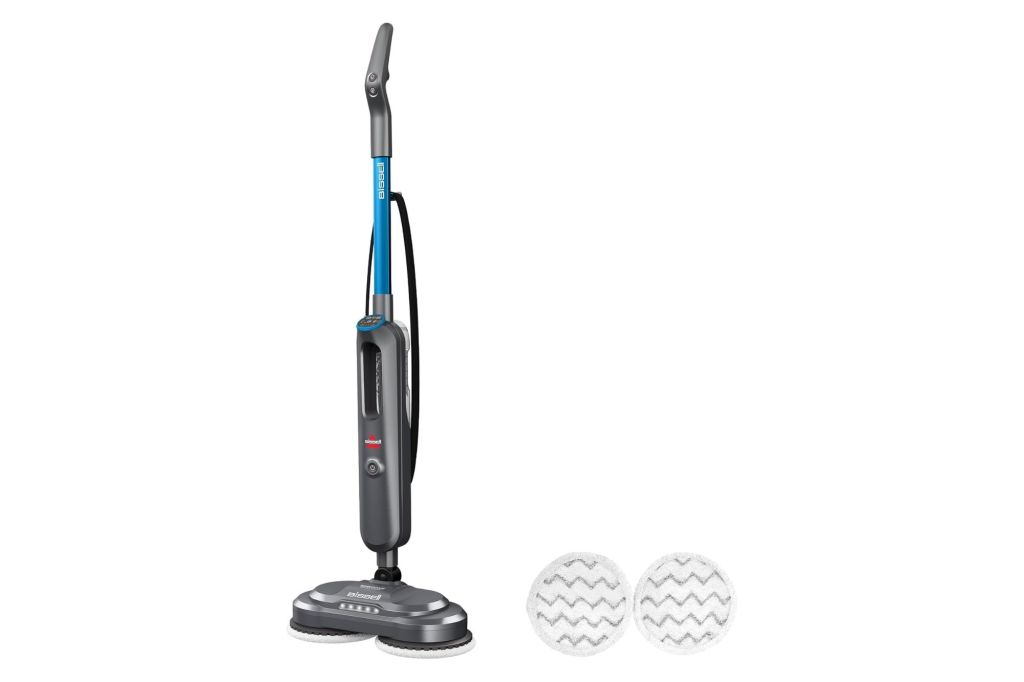
Pros:
- Doubles as a steam to remove ground between tiles
- Spin action removes the need to scrub
- Removable water tank for a more hygienic disposal process
- Up to 230 rotations per minute
Cons:
- Corded design means you always have to be near an outlet
While one of the pricier mops that we reviewed, it’s hard not to be impressed with the BISSELL SpinWave SmartSteam Scrubbing Steam Mop. Along with having spinning scrub pads, it features a steaming function to attack set-in stains. For this reason, we like it most for tile floors, especially in the bathroom area, though it’s difficult to maneuver around tighter spaces, such as around the toilet.
Noise-wise, it’s fairly quiet, offering a continuous stream of solution as you move from room to room. Seeing the amount of grime collected by the pads was beyond satisfying.
Style: Spin mop | Surfaces: Finished hardwood, Laminate, Tile, Vinyl| Weight: 12 pounds | Includes: Mop, 2 removable pads | Cord: 25 feet
Best Mop for Scrubbing Floors:
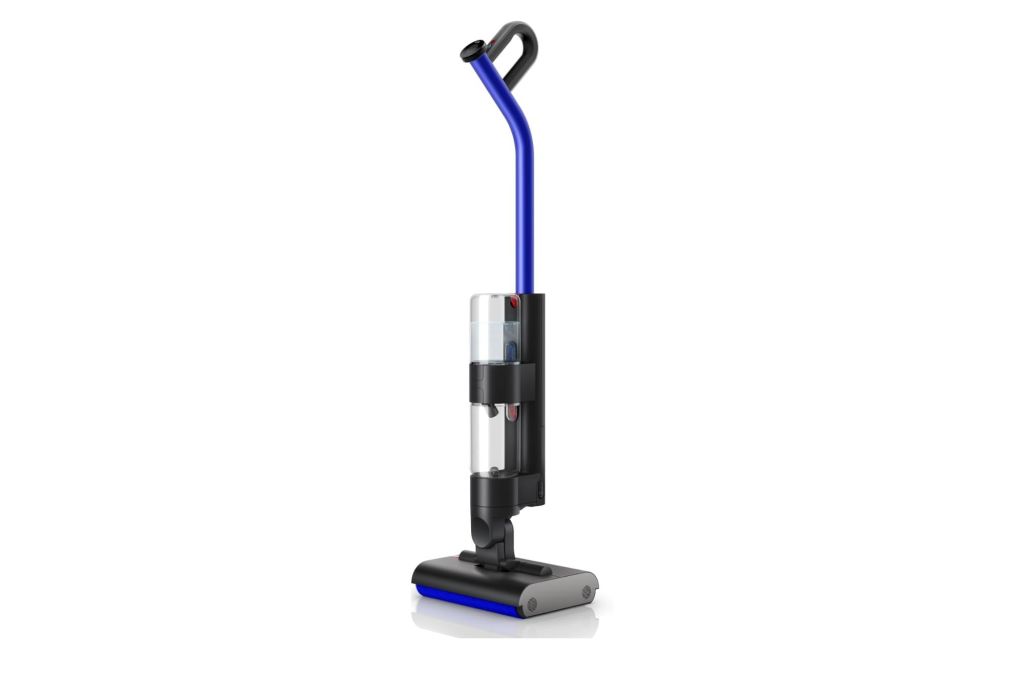
Pros:
- Precision control allows for the user to control how much cleaner is being used at a time
- Canister that separates larger pieces of debris from dirty water
- Max mode for older, hard to remove stains
- HEPA filter
Cons:
- No instruction manual. Users have to download the accompanying app to learn how to use it through videos
- Head isn’t flexible like a wet mop, so it’s difficult to clean crevices
We’ve reviewed our share of Dyson products at the Post, so we’re kind of experts on the brand’s exceptional technology. And while its WashG1 Wet Floor Cleaner doesn’t look (or act) like a regular wet mop, it’s the Tesla of its category. Designed specifically to wash hard floors, this futuristic mop can clean 3,100 square feet on one tank of water in 35 minutes. What makes it special is that it operates like a vacuum, sucking up larger chunks of debris while also washing. Its canister has two compartments that separate mess types, too, so you won’t be rinsing chunks of hair down the drain when you empty it.
The mop offers three different cleaning modes, all of which can be controlled and monitored on its LCD screen. There is a bit of a learning curve, which is expected but also a turn-off for the price. However, it’s an exceptional, splurgy-worthy device, especially if you want your floors to look like they’ve been professionally cleaned every time.
Style: Electric mop | Surfaces: Finished hardwood, Laminate, Tile, Vinyl| Weight: 10.5 pounds
Best Vacuum Mop Combo:
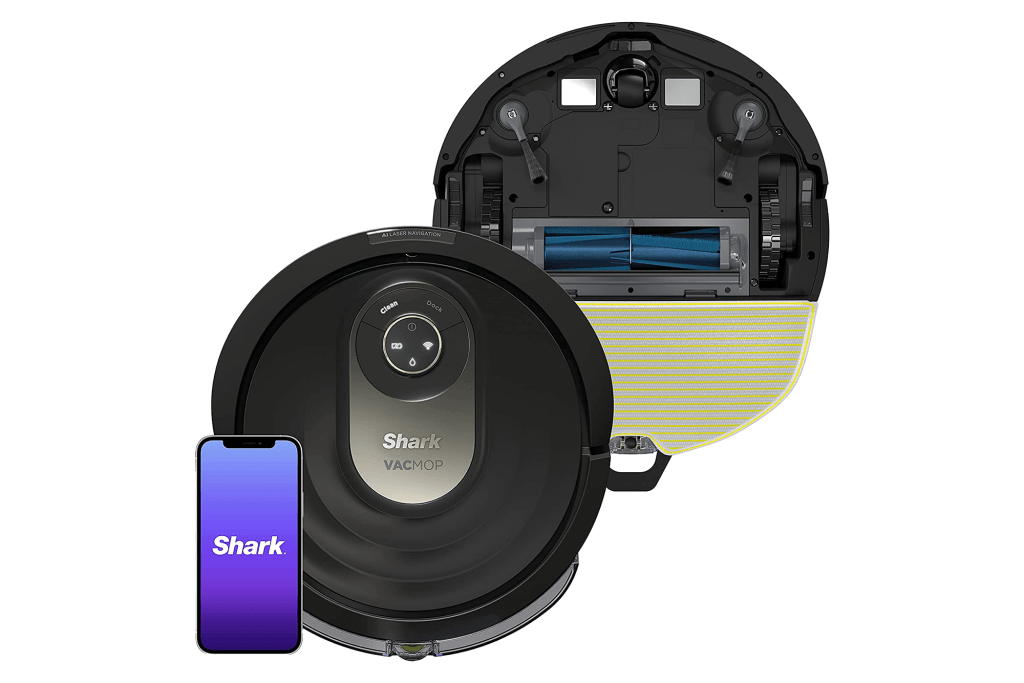
Pros:
- Can be programmed using your smartphone in the app.
- Able to detect carpet areas to avoid mopping (no one likes a soggy carpet!) as well as high-traffic areas to go over extra well — think the front hall or the pet’s room.
- The mop’s docking station is also a charger, so you never need to worry about it running out of battery.
- The mop can be run remotely, allowing you to do your chores when not at home.
- The water reservoir can also hold cleaning liquid for a deeper clean as opposed to just water.
Cons:
- The mopping pad gets dirty quite easily, so be sure to un-velcro and wash the pad between each use.
- The app can be finicky when mapping your home, so you may need to re-map a few times before the robot learns the layout of your home.
- Cannot be used without access to a power outlet and is less functional without the app.
We reviewed the Shark AI Ultra Robot Vacuum & Mop and it’s a unique mop-vacuum hybrid that’s offered in multiple variations, depending on your budget.
Breaking it down, the robot comes with two attachments: a regular vacuuming self-empty dust bin and a vacuum and mop 2-in-1 dust bin. The latter has a reservoir for water and a cleaning solution the robot vac uses to mops floors while also simultaneously vacuuming, eliminating the need to vacuum before you mop. It uses Shark’s trademark Sonic Mopping feature as well, getting floors clean the first time, without needing to go over any missed spots.
Style: Robot mop | Surfaces: Finished hardwood, Laminate, Tile, Vinyl, Carpet | Weight: 12.8 pounds
How we tested mops
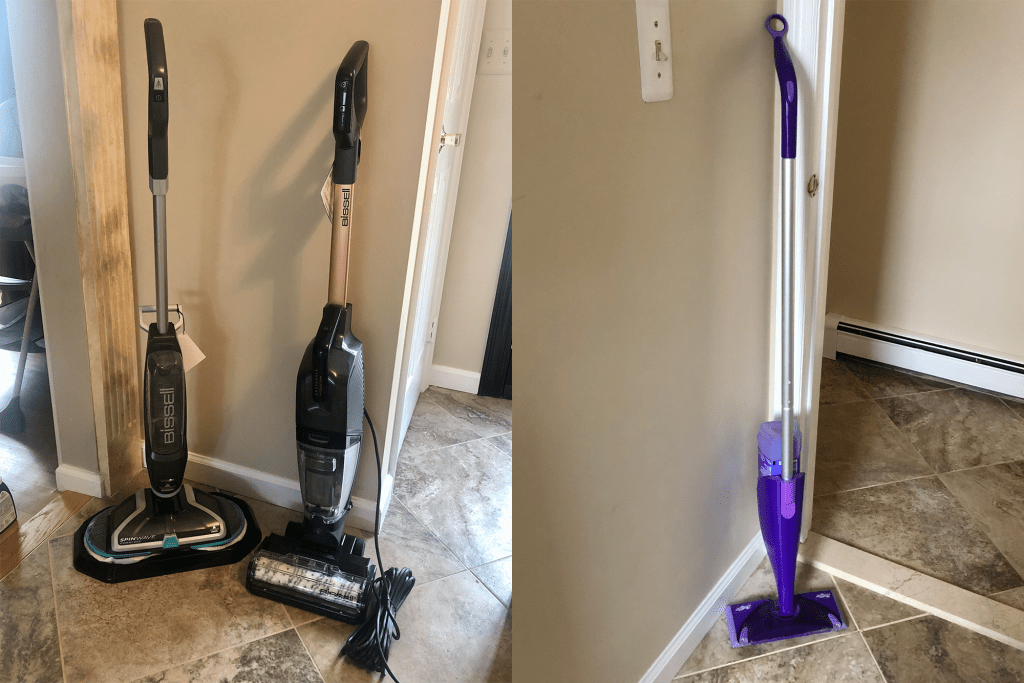
Here are the New York Post Shopping testing criteria when reviewing mops:
- Ease of use: Above all else, using a mop that doesn’t require much think-work is a high priority. From ergonomic handles to how streamlined the cleaning process is, we took this element into account.
- Efficacy of cleaning: Of course, you want a mop that actually picks up dirt and debris, while leaving your floors virtually streak-free (of course, they will be wet at first). We looked at the mop pads, depending on the model, and if there was leftover debris post-cleaning,
- Battery-charge time (if applicable): Some mops are smart, meaning they spin or require a battery charge. If that was the case, we compared the speed at which it takes a mop to generate a full charge from model to model.
- Added cost: Some models require corresponding solutions or replacement pads. While initial cost is a given, we also took into account how much of an investment certain mops are over time.
An FAQ on Mops
We turned to Melissa Maker, founder of Toronto-based cleaning service, Clean My Space (and author of her brand’s accompanying cleaning book), who provided expertise on what to look for in a quality mop, the different mops on the market, how to use them and more.
What to look for in a mop, according to a cleaning expert
Ahead, Maker lists some criteria to keep in mind when shopping for a brand-new mop:
- Build quality: Features like a metal pole, heavy-duty components that don’t feel flimsy are worth considering. Is the mop head or pad well made or does it look and feel like cheap material that will unravel or be non-absorbent? If a robot mop or steam mop, is it a trusted and known brand with good reviews?
- Comfort and convenience: Is the mop heavy (like a steam mop) or arduous to use (having to refill a reservoir), or do you have to bring a bucket around everywhere you go? Is the mop pole extendible or static (extendible means it’s more ergonomic). If it’s a robotic mop, how often do you have to refill it, and what’s the cleaning process like for the mop itself?
- Purpose: In other words, where can you use it? Do you need to buy multiple floor care tools or will this one handle more than one surface? Looking for a mop that works for your whole home, rather than getting one for one type of flooring and one for another, may be ideal.
The different types of mops, explained by an expert
Ahead, Maker explains each mop that you can find on the market, how they differ and what floors they’re best used on:
- Mops with disposable pads: These are useful for some ‘in-between clean’ mops but shouldn’t replace a proper mop. Consider this: you have to purchase refill pads which can add up and need room to store this extra mop. Their build can also be flimsy.
- Sponge mops: These are ‘old school’ mops but may not be the best options compared to others They may leave a lot of liquid behind, aren’t the most durable, and are the most difficult to clean, so they’re not apt for most household flooring. People like them for how easily they can be wrung out into a bucket (i.e. for your garage, cleaning other surfaces). Think about how gross a kitchen sponge can get, and imagine that cleaning your floor.
- Twist/spin mops: These are versatile and can be used on most flooring safely and with ease. Stay away from using these on hardwood or laminate, as excess moisture can seep into the planks, and the stringy nature of the mop head can leave streaks and uneven ‘wipe marks’ behind. If the head isn’t washed regularly and the mop water isn’t changed regularly, it can deposit dirt back onto the floor. However, they do allow you to put a lot of force into your mopping so you can ‘scrub off’ a really tough spill.
- Pad-style mops such as flat head or taco mops: These are safe for all flooring, the pads are easily swapped out and you can control the level of moisture used by using a spray bottle to spritz product onto the floor, or placing your pads into a bucket to pre-soak them and then wringing a clean pad out and use it until it’s soiled. Depending on the design of the mop, you can apply significant pressure to ‘scrub’ heavy stains. They are also easily able to navigate under and behind furniture. And, they are versatile, too: they allow you to clean walls and some people even use them to clean showers and tubs if they have mobility issues. What’s more, these are best for controlling moisture and streaks and are recommended for hardwood, laminate and vinyl flooring, as well as natural stone and tile.
- Steam mops: These are great for tile and natural stone as long as it’s sealed only; the steam can be damaging to unsealed or planked flooring and can also lift off finishes. They do take up space, which is a consideration, and they also have a bit of a learning curve. Pads do need to be laundered after each use.
- Robotic mops: These can be shaped like robotic vacuums, small and circular, or large 2-in-1 sweeper mops that lift up debris and mop at the same time. This technology is relatively new, and while the mapping capabilities have definitely improved over the past several years, the mopping and sweeping capabilities may not be as precise as you would like them to be.
How often should you mop your floors?
Of course, this depends on your lifestyle (how tidy you are, how often you are home), how many people live at home (less mopping for fewer people) and whether you have pets (they make floors dirtier).
“My kitchen and bathroom get mopped at least once a week, and my living spaces (rec room, offices, bedrooms, etc.) much less so, perhaps once a month or more frequently as needed (this is because I have hardwood and they do not like to be wet mopped),” Maker explained. “We vacuum the hardwood two to three times per week since we have a young child and a cat and we do not wear shoes inside the house.”
However, Melissa mops tiled spaces more frequently because these floors can withstand it. “Knowing your lifestyle and habits will dictate how frequently you should mop; and looking at the floors will be the ultimate tell: if they have splash marks, dull marks or stains, then you know it’s time,” she added.
How to mop your floors, according to an expert
Ahead, Maker provides a step-by-step guide for mopping your floors like a pro:
- Make sure your floor is free from any dust and debris before you mop. You’ll want to pick up any large pieces of food or garbage that may be lying around and sweep or vacuum or dry mop any of the small pieces of crumbs.
- Prepare your mop solution (this will depend on the kind of floor you have as well as the mop you are using).
- Ensure your mop head or pad is clean
- Move large objects and furniture out of the way
- Mop starting at the opposite corner of the exit point of the room (this way you mop yourself out the door instead of into a corner).
- Use a ‘W’ pattern when mopping using a flat head or steam mop — an overlapping pattern forming a ‘W’ shape using long strokes, and an ‘S’ pattern if using twist/spin mop — an ‘S’ or figure 8 motion working from left to right, top to bottom.
- Finish up by doing a dry wipe if necessary using a flat head or taco mop with a dry microfiber cloth or pad attached.
Expert tips for mopping your floors that you should keep in mind
Above all else, working smarter and not harder is the goal. That said, there are a few tips and tricks Maker notes that you should keep in mind while mopping.
“If using a bucket, place a ‘coaster’ underneath (a dry cloth) so that the bucket doesn’t leave a water ring or splashes are easily picked up by the cloth,” she recommended. “In general, you can wet mop most floors without any issue, but you never want to soak the surface as it can cause permanent damage and it’s not necessary.”
The exception is hardwood or plank flooring, and in this case, you really want to stay away from excess moisture as much as possible.
Additionally, your pad should be damp, not wet. “When I mop with my taco mop, the floor is dried within seconds of me finishing,” she added. “High-polish flooring such as certain ceramic or porcelain tile, slate or marble, would definitely benefit from a dry wipe afterward to leave that high-polish shine.”
How to clean your mop, according to an expert
It seems like an oxymoron — cleaning your cleaning device. But, just like cleaning your dishwasher, it should be done regularly to (1) ensure the longevity of your mop and (2) keep things sanitary.
“Rinse any mop head, regardless of the type, after each use to remove detergent, dirt and debris,” Maker began. “Following this, I believe flat-head mop and steam mop pads should be laundered after each use. I would also recommend spin or twist mop heads get laundered frequently as well or at the very least, rinsed well and air dried.”
Should a mop have different attachments?
Steam mops will come with them, but generally, a mop should have one type of head or pad. “Pad-style mops may come with different types of pads for different uses, and can be used in different parts of the home,” Maker noted.
Should a mop have a mop head-release mechanism to avoid coming in contact?
Some mops come with a release-style mechanism so you’re never touching debris that your mop recently picked up. It’s certainly not a deal-breaker, but a surefire bonus if it comes with one.
“It’s definitely convenient to have one for a spin or twist mop, and unless you’re mopping up a corrosive substance, there’s no reason why you can’t use your hands to release the mop head or pads after use,” Maker pointed out. “If you’re feeling iffy about touching the dirty mop head or pads, a pair of rubber cleaning gloves will suffice.”
Can you mop all types of floors?
Unfinished or waxed wood flooring you would want to avoid mopping, and specialty floors such as certain types of cork or rubber flooring (that you may see in an at-home gym) will have to be cleaned according to manufacturer’s or installer’s instructions, per Maker.
How often should your mop head be replaced?
According to Maker, your mop handle should last if you’re buying a good-quality one. “Pads or heads should be replaced when they look worn or discolored,” she advised.
When is it time to buy a new mop?
“When it comes to cleaning tools and supplies, I like to ‘buy once, buy well,'” Maker noted (which is why it’s important, in our opinion, to invest in a quality one we reviewed). “I find that if I make an initial investment in good quality items, they’ll last and do their job better so I don’t have to work as hard, or spend more money replacing items that are constantly breaking or falling apart.”
Why Trust Post Wanted by the New York Post
This article was written by Victoria Giardina, New York Post Commerce Journalist & Content Strategist. Victoria tests the latest and greatest cleaning products to compare the best results from household cleaners, appliances and vacuums (yes, she’s reviewed and ranked nearly every Dyson). Armed with expert recommendations and FAQs, she evaluates formulas, functions and features to determine the very best items on the market – and goes the extra mile to find them on sale. Victoria has been creating shopping guides for the New York Post since 2021 and previously held positions at Insider Reviews and CNN Underscored.
Hunting for a headline-worthy haul? Keep shopping with Post Wanted.








